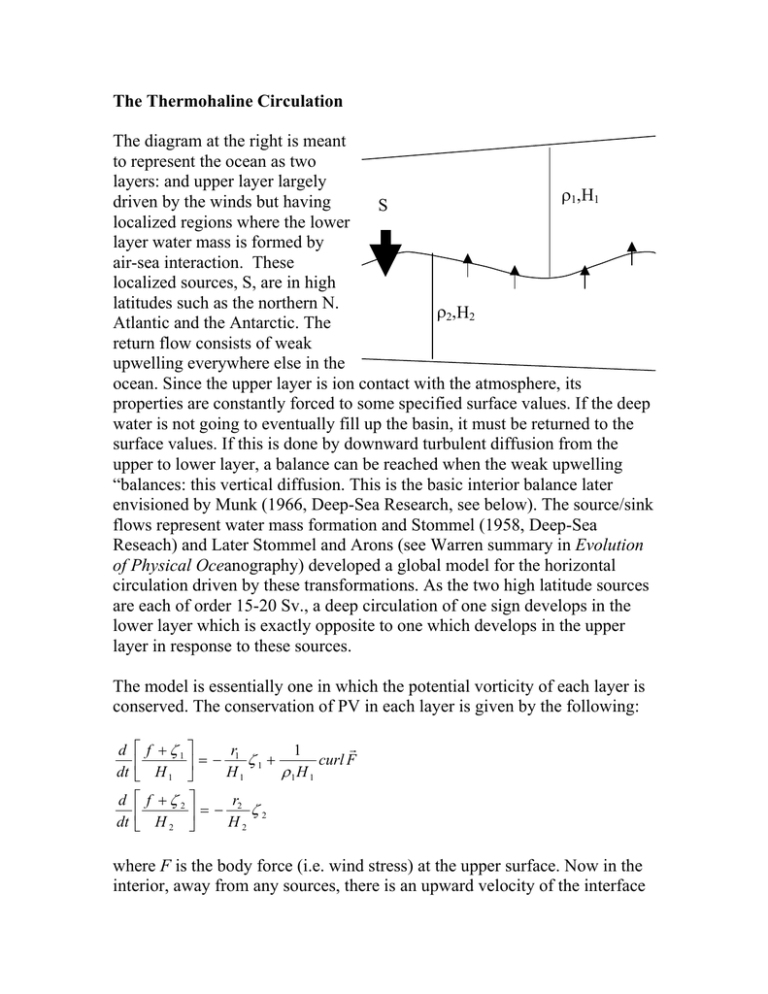ρ ,H
advertisement

The Thermohaline Circulation The diagram at the right is meant to represent the ocean as two layers: and upper layer largely ρ1,H1 driven by the winds but having S localized regions where the lower layer water mass is formed by air-sea interaction. These localized sources, S, are in high latitudes such as the northern N. ρ2,H2 Atlantic and the Antarctic. The return flow consists of weak upwelling everywhere else in the ocean. Since the upper layer is ion contact with the atmosphere, its properties are constantly forced to some specified surface values. If the deep water is not going to eventually fill up the basin, it must be returned to the surface values. If this is done by downward turbulent diffusion from the upper to lower layer, a balance can be reached when the weak upwelling “balances: this vertical diffusion. This is the basic interior balance later envisioned by Munk (1966, Deep-Sea Research, see below). The source/sink flows represent water mass formation and Stommel (1958, Deep-Sea Reseach) and Later Stommel and Arons (see Warren summary in Evolution of Physical Oceanography) developed a global model for the horizontal circulation driven by these transformations. As the two high latitude sources are each of order 15-20 Sv., a deep circulation of one sign develops in the lower layer which is exactly opposite to one which develops in the upper layer in response to these sources. The model is essentially one in which the potential vorticity of each layer is conserved. The conservation of PV in each layer is given by the following: r d f +ζ1 r1 1 = − + curl F ζ 1 dt H 1 H1 ρ1H 1 d f +ζ2 r = − 2 ζ2 dt H 2 H2 where F is the body force (i.e. wind stress) at the upper surface. Now in the interior, away from any sources, there is an upward velocity of the interface which we will take to be a constant = w0: H1=H01 - w0t, H2=H02 + w0t. If these are inserted into the above, we can obtain a pair of equations for the linearized vorticity of the layer [this follows what we did for the wind-driven circulation]. These are: βv1 + r f 1 = − + w r curl F ζ 0 1 1 H10 ρ1 βv2 − f w0 = − r2ζ 2 H 20 We will now integrate these over the layers and use the definition of wind stress at the upper surface. Here please note that while the current in each layer is uniform with depth (or nearly so), the friction parameter is not: it is strong near the surface and bottom and perhaps near the interface. The integration results in an average of the friction parameter in each layer. This procedure assumes that the variable topography of the internal interface and bottom can be ignored (i.e. flat). Thus we obtain the following: β ∫ dzv1 = − fw0 − r1 ∫ dz ζ 1 + 1 1 ρ1 r curlτ β ∫ dzv2 = + fw0 − r2 ∫ dz ζ 2 2 We have something like the Sverdrup interior balance (ignoring frictional terms) for the upper layer, which is augmented by an upwelling across the interface, while in the deeper layer, a circulation opposite to that in the upper layer is driven by the upwelling. This upwelling results in a poleward interior flow everywhere in the deep layer and an equatorward flow everywhere in the upper layer driven by the thermohaline mass exchange. The flow schematic in the book (fig. 6.40, p. 240) is for the lower layer. What emerges from the above balance is the importance of western boundary currents in redistribution of the required transport for the interior. The Stommel/Arons model has not been verified in detail for the interior of the ocean, but its inferences about the location and direction of abyssal flows has been one of the few theoretical predictions made before the observations of strong, deep wbc’s were made which later support it! Note that the upper layer circulation (opposite to that plotted in the figure) will be such as to increase northward transports in Gulf Stream over winddriven dynamics, but will decrease transport of the Brazil Current, because the two flows are opposed. The actual flows in the western boundary currents are, much like those for the wind-driven circulation, dependent crucially on the nature of the frictional damping with Stommel- and Munktype boundary layers. This thermohaline circulation is an internal mode which vanishes if we average vertically over both layers. It is ultimately tied to the interior balance reflected by Munk’s famous Abyssal Recipies paper (referenced above- in 1966): the cold water injected into the deep layer must be “converted” to warm water in the upper layer by diffusive processes. This is often overlooked, but it is a central element of the theory. Numerical work with more complicated thermohaline models shows that this is indeed the case: the strength of the overturning circulation is proportional to the amount of small-scale vertical diffusion of heat/salt/density in the ocean. How big is the vertical velocity driving the above? Warren estimates that for a lower layer thickness of 3 km, with total source strength of 34 Sv. of deep water formation, mean vertical velocities will be approximately 1.5 x 10-7 m/s, horizontal interior flows of order 10-3 m/s and western boundary transports of order 10 Sv. [=107 m3/s]. Abyssal Mixing If we model the vertical flux of salinity (for example) in the deep water as a balance between vertical advection and vertical mixing, the latter is modeled as an eddy-diffusivity so that small-scale turbulent fluxes of salinity are given by − ρ < w' S ' >= ρκ ∂<S> = ρw < S ( z ) > ∂z where κ is a vertical eddy diffusivity. If we insert typical values for the vertical variation of salinity and the above estimate for the vertical velocity, we can get an estimate of the vertical diffusivity required for an overall balance of the thermohaline circulation: κ ≈ 10-4 m2/s, one of the canonical numbers in oceanography.


